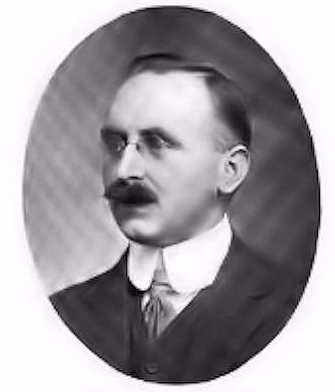
Major
WILLIAM HENRY MERRETT, T.D.
Royal Engineers (Volunteers)
by
Lieutenant
Colonel Edward De Santis, MInstRE
Ó 2018. All Rights Reserved.

Major William Henry Merrett,
T.D.
This account of the life and military service of William Henry Merrett
resulted from the acquisition in 1989 of his Volunteer Long Service Medal.
In 1989, and for many years thereafter until the development of the
Internet, the story of the recipient of this type of medal was difficult if not
impossible to write. Now, almost 30
years later, an enormous amount of information regarding his life is available
on the web.
Merrett was an eminent scientist, engineer, researcher and teacher and
was particularly prominent in the field of metallurgy.
He was a member of many engineering and scientific institutions including
the following:
A.R.S.M.: Associate of the Royal School of Mines.
F.I.C.:
Fellow of the Royal Institute of Chemistry
M.I.M.M.: Member
of the Institution of Mining and Metallurgy
M.A.I.M.E.: Member of the American Institute of Mining Engineers
A.M.I.E.E.: Associate
Member of the Institution of Electrical Engineers.
F.C.S.: Fellow of the Chemical Society.
M.I.S.I.:
Member of the Iron and Steel Institute.
M.I.M.: Member of the Institute of Metals.
Life Member of the British Association, a learned society founded in 1831
to aid in the promotion and development of science.[1]
That Merrett was a “joiner” there can be no doubt, but one must
consider the intellect and energy that he must have possessed to have been an
Associate member, a full Member and a Fellow in nine professional organizations.
One must also consider the diversity of his professional life to include
mining, metallurgy, chemistry and electrical engineering.
His work in these various fields, in addition to his military service,
will be discussed in this narrative of his life to the extent that the author
was able to uncover his accomplishments in each area.
The principal references used in the preparation of this narrative were from a number of sources. They include census records, official registries in the United Kingdom, Merrett’s military service papers, and The London Gazette. All sources are contained in the REFERENCE section at the end of the narrative and are cited throughout in the ENDNOTES. Every effort has been made to accurately portray the life and military service of Major Merrett.
Henry Merrett, the father of William Henry Merrett, was born in Battersea, Surrey in 1850. Henry was the son of James Merrett (1816-1890) and Sarah Merrett, née Thrift, (1825-1853). William Henry’s mother, Frances (Fanny) Hatherley, was born in Stokenham, Devonshire in 1841. Henry and Fanny were living at 80 Orchard Street in Clapham, Surrey when William Henry was born on the 18th of December 1871.[2] In the census taken in 1871 Henry’s occupation is listed as Iron and Metal Warehouseman. Henry and Fanny had married early in 1871.
William Henry Merrett was baptized in Holy Trinity Church in Clapham on the 14th of January 1872. Holy Trinity is an Anglican church located in Clapham Common North Side and is still an active church.
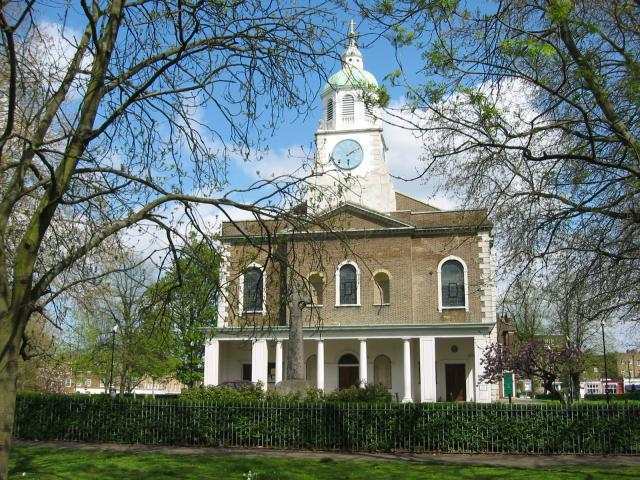
Figure 1. Holy Trinity
Church, Clapham, Surrey.
(Photograph courtesy of the Holy Trinity Church web site)
Table
1. 1881 Census of England and Wales:
James Merrett Household.
|
Census
Place: Saint John’s Parish,
Croydon, 2 Wandle Road.[3] |
|||||
|
NAME |
RELATION |
MARITAL STATUS |
AGE |
OCCUPATION |
WHERE BORN |
|
James
Merrett |
Head |
Married |
29 |
Surveyor’s
Clerk |
Battersea,
Surrey |
|
Jane
P. Merrett |
Wife |
Married |
37 |
|
Holloway,
London |
|
Ernest
J. Merrett |
Son |
|
6 |
|
Croydon,
Surrey |
|
Harold
T. Merrett |
Son |
|
1 |
|
Croydon,
Surrey |
|
William
H. Merrett |
Nephew |
|
9 |
|
Clapham,
Surrey |
Table
2. 1891 Census of England and Wales:
Henry Merrett Household.
|
Census
Place: St. Mary’s Parish,
Lambeth, Surrey, 30 New Cut.[4] |
|||||
|
NAME |
RELATION |
MARITAL STATUS |
AGE |
OCCUPATION |
WHERE BORN |
|
Henry
Merrett |
Head |
Married |
41 |
Metal
Warehouseman |
Battersea,
Surrey |
|
Fanny
Merrett |
Wife |
Married |
47 |
|
Stokenham,
Devonshire |
|
William
Henry Merrett |
Son |
Single |
19 |
Natural
Science Student |
Clapham,
Surrey |
|
Henrietta
Merrett |
Daughter |
|
11 |
|
Battersea,
Surrey |
Table
3. 1911 Census of England and Wales:
Henry Merrett Household.
|
Census
Place: Wallington, Surrey,
“Hatherley” 35 Grosvenor Road. |
|||||
|
NAME |
RELATION |
MARITAL STATUS |
AGE |
OCCUPATION |
WHERE BORN |
|
Henry
Merrett |
Head |
Married |
61 |
Manager
Secretary, Hydraulics Engineer |
Battersea,
Surrey |
|
Fanny
Merrett |
Wife |
Married |
70 |
|
Stokenham,
Devonshire |
|
William
Henry Merrett |
Son |
Single |
39 |
Assistant
Professor of Metallurgy |
Clapham,
Surrey |
|
Annie
Laflin |
Servant |
Single |
27 |
General
Servant (Domestic) |
Croydon,
Surrey |
Physical Description
The only physical description of available of William Henry Merrett can be discerned from the portrait photograph at the beginning of this narrative and from the entries in a medical examination given him in October of 1922. The photograph, probably taken when he was in his forties, shows a man with an oval-shaped face and a receding hairline of dark hair graying on the sides. His pince nez glasses and large mustache give him the look of an academic. In October of 1922 he was described as a man 5 feet 8 inches tall weighing 168 pounds. His maximum and minimum chest measurements were given as 41½ inches and 38½ inches, respectively. His uncorrected visual acuity was rated as 6/36 and his corrected vision with his glasses as 6/6.[5] At the time of this examination Merrett was required to provide a medical history. He indicated that up to this point in his life he had never suffered from any serious illness or injury and to his knowledge he had no mental or physical disabilities and that he had never suffered from “fits” of any kind. He was basically in good health for a man 51 years of age.
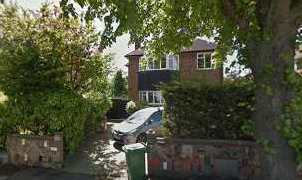
(Photograph courtesy of Google Earth)
Education
St Olave’s Grammar school has occupied a number of significant sites in
its four hundred odd year history on the south bank of the London River.
Most notable among these sites is the still extant 1895 building adjacent
to Tower Bridge, designed in the Queen Anne Revival style by E.W.
Mountford (Old Bailey, Sheffield and Northampton Town Halls).
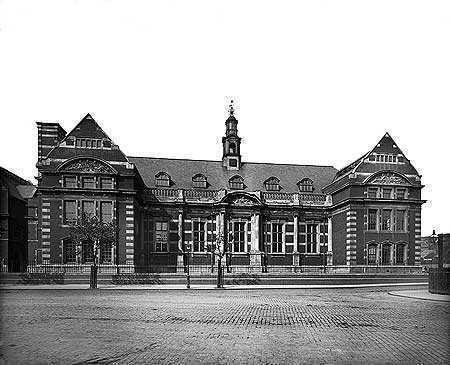
Figure 3.
St. Olave’s Grammar School on Elizabeth Street as it Appeared when
William Henry Merrett was in Attendance.
(Photograph
courtesy of the St. Olave’s web site)
Following his grammar school studies at St. Olave’s, William attended the Royal School of Mines. The Royal School of Mines was established in 1851 as the Government School of Mines and Science Applied to the Arts. The School developed from the Museum of Economic Geology, a collection of minerals, maps and mining equipment made by Sir Henry De la Beche, and opened in 1841. The museum also provided some student places for the study of mineralogy and metallurgy. Sir Henry was the director of the Geological Survey of Great Britain and when the collections outgrew the premises the museum and the survey were placed on an official footing with government assistance.
The Museum of Practical Geology and the Government School of Mines and Science Applied to the Arts opened in a purpose-designed building in Jermyn Street in 1851. The officers of the Geological Survey became the lecturers and professors of the School of Mines. The Royal College of Chemistry was merged into it in 1853. The name was changed in 1863 to the Royal School of Mines, and was moved to South Kensington in 1872, leaving the Museum of Practical Geology behind in Jermyn Street. In 1907, the RSM was incorporated into Imperial College of Science and Technology.[6]
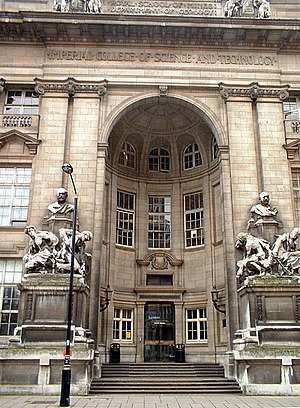
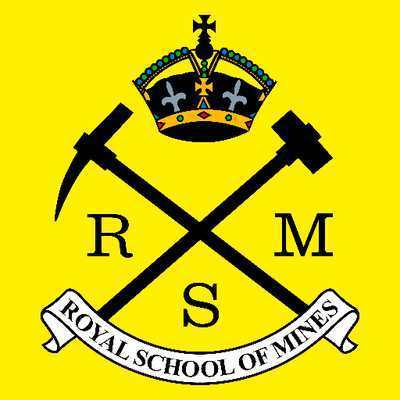
Figures
4 and 5. The Entranceway and Logo of
the Royal School of Mines.
(Images
courtesy of Wikipedia.com)
The 1891 census shows that William had entered the Royal School of Mines as a Royal Exhibitioner and that in the year of that census he was a Natural Science Student at the Royal School of Mines. A Royal Exhibitioner (i.e. scholarship winner) was entitled to free instruction at the Royal School of Mines and £50 per annum maintenance allowance while studying there. William obviously had demonstrated his academic skills at an early age.
The Records of the Honorable Society of Lincoln’s Inn shows that William Henry Merrett was admitted to the society on the 19th of May 1906 while he was an Assistant Professor of Metallurgy at the Royal School of Mines in South Kensington. His admission to this society is somewhat of a mystery as the society was the domain of barrister or individuals studying law.
In 1894 William completed the course for Apprenticeship at the Royal School of Mines with a First Class Diploma in Metallurgy. He became a Junior Assistant in the Research Laboratory of the Royal Mint and a private research assistant to Sir William Roberts-Austen.[7]
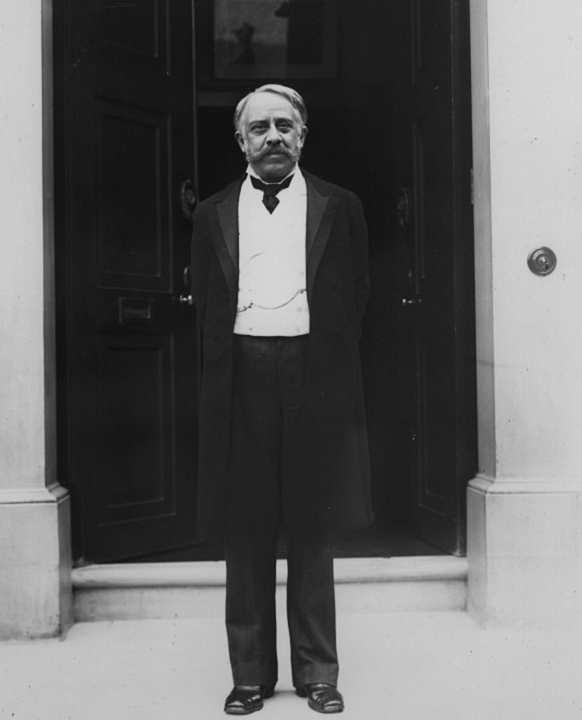
Figure
6. Sir William Chandler Roberts-Austen
KCB.
(3 March 1843 – 22 November 1902). Outside the Royal Mint at Tower Hill.)
(Photograph courtesy of Wikipedia.com)
Sir William was an English metallurgist noted for his research on the physical properties of metals and their alloys. The austenite class of iron alloys is named after him. He was born William Chandler Roberts in Kennington, Surrey, the son of George and Maria née Chandler Roberts. He later (1885) assumed the name of Roberts-Austen at the request of his uncle, Major Austen, as a condition of inheritance. He was educated privately and at the Royal School of Mines (1861–1865). He was appointed Assistant to the Master of the Mint and then Chemist of the Royal Mint (1869), Professor of Metallurgy at the School of Mines (1880) and Chemist and Assayer to the Royal Mint (1882–1902). He developed procedures for the analysis of alloy constituents and an automatic recording pyrometer used to record temperature changes in furnaces and molten materials. He became a world authority on the technical aspects of minting coins. His work had many practical and industrial applications.
Roberts-Austen was elected a Fellow of the Royal Society in June 1875 and was their Bakerian Lecturer in 1896. He was made CB in 1890 and knighted (KCB) in 1899. He was also a Chevalier of the Legion d'honneur.
Sir William was largely responsible for the building of St Martin's chapel of ease, Blackheath in 1893. He died at his residence in the Royal Mint and was buried in St Martin's churchyard, Canterbury, Kent.
3.
PROFESSIONAL CAREER
Work
History
It was during the period of Sir William’s research at the Royal Mint that William Henry Merrett worked with him and for him. In 1896 Merrett worked on the report of the Committee on Steel Rails, a project he undertook until 1900.[8] In 1898 he became a Senior Research Assistant under Sir William and worked with the Alloys Research Committee. At this time he also was employed on investigations for Her Majesty’s Explosives and Ordnance Committees.[9]
In 1901 Merrett was awarded the Edward Matthey Prize from the Royal School of Mines. This prize consisted of the proceeds of a gift of 300 guineas from Edward Matthey, Esq., which was awarded each year to the Associate of the Royal School of Mines who had conducted in the Metallurgical Laboratory a research which, in the opinion of the Council, was of sufficient merit to deserve the prize, the sum to be expended in the purchase of books or instruments, or in some way approved by the Professor of Metallurgy. Merrett was, at this time, an Assistant Metallurgist and Instructor in the Royal School of Mines, a position that he maintained until 1908.
The seven years spent by Merrett in the closest association with Roberts-Austen, who always regarded him with great esteem and affection, were very eventful years in the progress of physical metallurgy in relation to the adaptation of materials to structural and engineering purposes. The research, which had occupied Roberts-Austen continuously from the time of his own association with Thomas Graham (who, as the last executive officer to hold the title of "Master of the Mint," had inspired his early efforts), was now rapidly coming to fruition, and was being embodied in the Reports of the Alloys Research Committee which had been set up on the initiative of the Institution of Mechanical Engineers.
William Merrett became a whole-time member of the staff at the Royal School of Miner in 1902 working under Professor William Gowland, F.R.S. William Gowland was a mining engineer who carried out archaeological work at Stonehenge and in Japan. He has been called the "Father of Japanese Archaeology.”
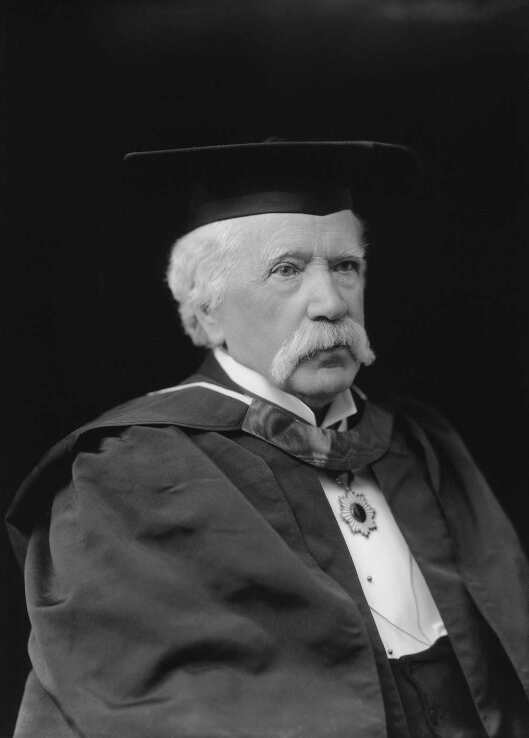
(Photograph courtesy of Wikipedia.com)
In 1904 Merrett completed the work on the heat treatment and photo-micrography of steel that had been started by Sir William C. Robert-Austen. During Roberts-Austen's direction of the Metallurgical Department of the Royal School of Mines several improvements were inaugurated. Micro-metallurgy was taught systematically, the instruction in that subject was entrusted to Merrett. Merrett, by his geniality, made himself very popular with the students. He stimulated their military interests as well as teaching them technical subjects, so that when the country required their services during war time, Royal School of Mines men volunteered in large numbers. Merrett himself at once setting the example, went on active service.[10] The details of this service will be covered in another section of this narrative.
On the 8th of February 1904 Merrett delivered a lecture on the Works of the Alloys Research Committee of the Royal School of Mines. His lecture was published in the Proceedings of the Institute of Mechanical Engineers, Parts 3-4, 1904, pages 1319 to 1352. In the heading of the published lecture he is shown as “Mr. William H. Merrett, A.R.S.M., Instructor in the Metallurgical Division of the Royal School of Mines. Formerly Assistant to the Alloys Research Committee.” The lecture is very detailed and technical. It can be found on the Internet under the I.M.E. proceedings of 1904.[11]
The immense amount of pioneer experimental work which is represented in a very condensed form in Merrett’s lecture was carried out by Henry C. Jenkins, Alfred Stansfield, and Merrett. While Merrett worked in close association with Stansfield in the development and application of pyrometric methods to the study of metals and alloys, it is to Merrett alone that credit must be given for responding so eagerly to Roberts-Austen's clear visions of the future importance of metallography. Much of the apparatus used at that time was constructed by Merrett himself and, stimulated by a technique which had been developed in France, he set himself the task of providing photomicrographs, to accompany Roberts-Austen's Reports, which surpassed anything which had been published in Great Britain at that time
As previously indicated, Merrett was admitted to the Honorable Society of Lincoln’s Inn on the 19th of May 1906 while he was a Lecture in the Royal School of Mines, a position he held until 1911. By 1911 he had been elevated to the position of Assistant Professor of Metallurgy at the Royal School of Mines and also was a Member of the Faculty of Engineering and the Board of Studies in Mining and Metallurgy at the University of London.[12] In December of 1911 he was promoted to the rank of Professor in the Royal School of Mines[13] and he continued in this capacity until he was called up for active service in the Great War of 1914-1918, service that he performed entirely at home during the war years.
Following the war his later years were mainly concerned with iron and steel, comprising, in addition to the Research Reports, a lengthy investigation for a Departmental Committee of the Board of Trade on the "Wear of Steel Rails " (following a disaster at St. Neots)[14] and numerous inquiries on behalf of the War Office and Admiralty in relation to gun steels and the erosion of gun tubes. Working with Professor William Gowland until Gowland’s death, he completed the unfinished Sixth Report to the Alloys Research Committee. From that point Merrett's metallurgical activities were confined almost exclusively to teaching, until his retirement in 1937.
Merrett was a member of the Royal Societies Club, an independent
scientific academy of the United Kingdom and the British Empire and
Commonwealth, dedicated to promoting excellence in science.
He also was a member of the Mining and Metallurgical Club.
The Mining and Metallurgical Club was established in 1910 to
provide a meeting place for engineers and individuals from companies engaged in
the mining industry. The founding members were closely linked to the Institution
of Mining and Metallurgy (IMM). Amongst the 74 original members of the Club was
Herbert Clark Hoover (later President of the United States of America), who at
that time had a consulting mining engineering practice in London.
Based at 3 London Wall, City of London, the Club provided members dining,
music, games and space for other social functions.
Professional Associations
As indicated in the Introduction of this narrative, William Henry Merrett was a member of many professional organizations in many grades of membership. Details regarding his grades of membership and the dates on which they were conferred are provided in this section, so far as the author was able to determine.
He was an Associate of the Royal School of Mines (A.R.S.M.) early in his professional life owing to his work with that institution as early as 1891 when he entered the school as a student and rose to the rank of Professor by 1911.
Founded in 1877 as the Institute of Chemistry of Great Britain, its role was to focus on qualifications and the professional status of chemists and its aim was to ensure that consulting and analytical chemists were properly trained and qualified. Merrett undoubtedly qualified for membership in this organization based on his research work with metals and he ultimately rose to the grade of Fellow (F.I.C.) indicating full training and professional competence. He also was an Examiner in metallurgical subjects within the institute.
The Institution of Mining and Metallurgy was founded in 1892 as a
research institution and was probably the primary organization to which Merrett
belonged given his life-long work with metallurgy.
It was only natural that he would be a Member of the Institution of
Mining and Metallurgy (M.I.M.M.).
In 1912 Merrett became a Member of the American Institute of Mining Engineers (M.A.I.M.E.).[15] This membership probably was bestowed upon him based on his prominence in the fields of mining and metallurgy. He is specifically mentioned in the institute’s bulletin of May 1919 on the Honor Roll of those who served in the Great War, with the entry in the bulletin reading:
“Merrett, William H., Major, London Electrical Engineers, Royal Engineers, B.E.F.”
Based on Merrett’s expertise in chemistry and as an F.I.C. it seem only logical that he also would have been a Fellow of the Chemical Society (F.C.S.) the aims of which were to hold meetings for the communication and discussion of discoveries and observations in chemistry and to publish accounts of such discoveries.
The Iron and Steel Institute was an English association organized by the iron trade of the north of England. Its object was the discussion of practical and scientific questions connected with the manufacture of iron and steel. As a metallurgist this was an organization to which Merrett could contribute much; hence, he became a Member of the Iron and Steel Institute (M.I.S.I.).
As a Member of the Institute of Metals (M.I.M.) Merrett would have been in his element as a bona fide metallurgist of prominence. He was in fact one of the original members of this institute and a member of the Governing Body of the Camborne School of Metalliferous Mining. The Camborne School of Mines, commonly abbreviated CSM, was founded in 1888. Its research and teaching was related to the understanding and management of the Earth's natural processes, resources and the environment. It located at the Penryn Campus, near Falmouth.
Although there is no record showing that Merrett studied electrical engineering, he became an Associate Member of the Institution of Electrical Engineers (A.M.I.E.E) at some point in his professional career and remained an Associate Member his entire life. The fact that he remained an Associate Member was probably due to the fact that he had no academic credentials in the field; however, his work on the Alloy Research Committee provided him with much experience in the fields of electricity and electrical engineering. Through his work on the committee he became intimately acquainted with galvanometers, thermo-electric pyrometers, thermo-couples and other sophisticated electronic devices. His experience in this field and his membership in the I.E.E. undoubtedly led to his employment with the London Electrical Engineers, a branch of the Royal Engineers, during his time in the Army.
Finally, it is not surprising that a man of Merrett’s intellect would become a Life Member of the British Association. As the aim of this society was the promotion and development of all branches of science, it is only natural that he would be attracted to the association.
4.
MILITARY SERVICE
Enlistment
In 1888 William Henry Merrett joined the 3rd Middlesex Artillery Volunteers. At that time the unit consisted of the following divisions:
The 1st Division with headquarters at Armoury House on Farringdon Road in London.
The 2nd Division with headquarters on Lower Kensington Lane in southeast London.
The 3rd Division with headquarters on Porteous Road in Paddington.
In 1890 the Duke of York became the Honorary Colonel of the regiment and in 1896 the unit won the Queen’s Prize for Position/Heavy Artillery.
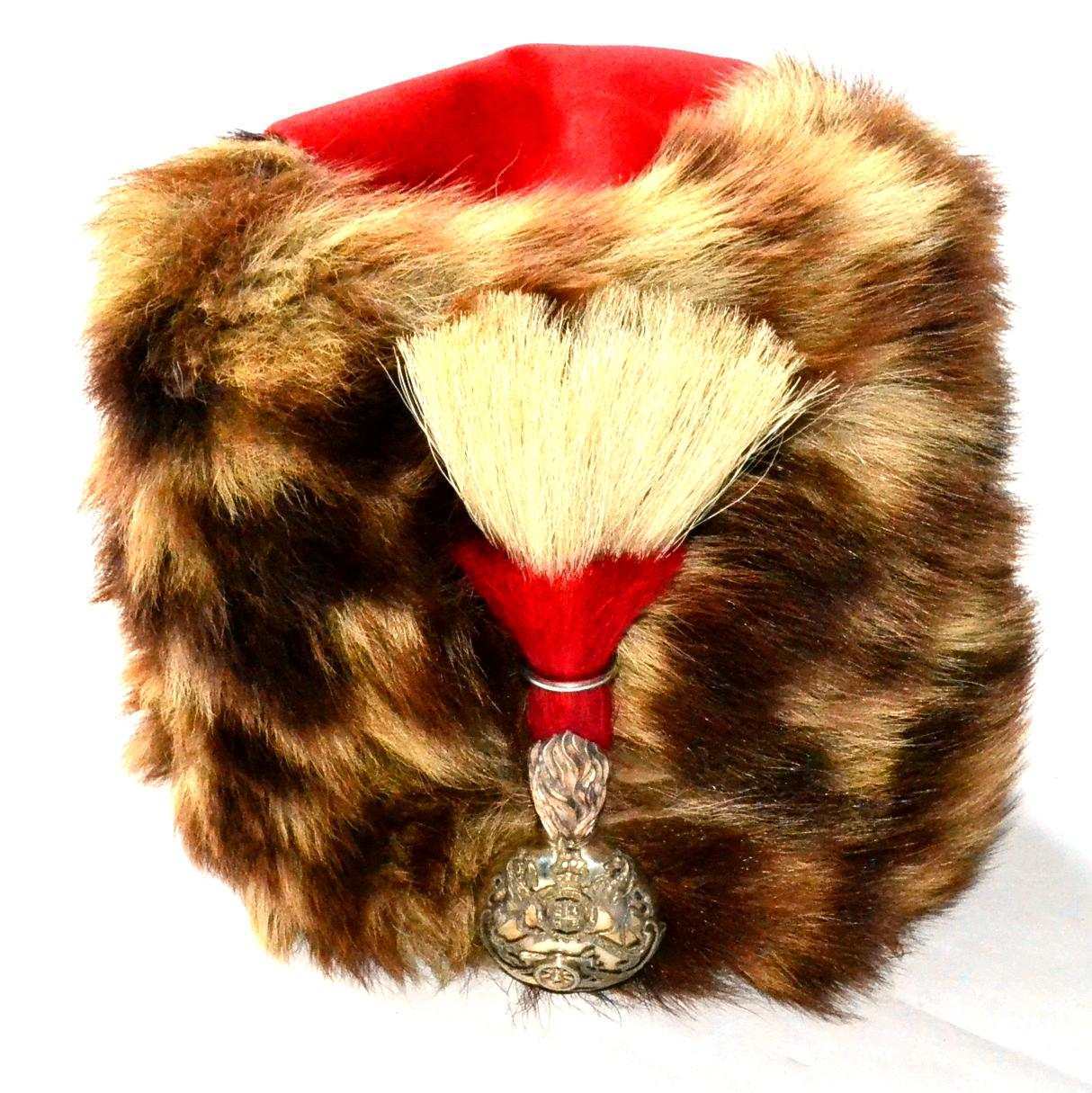
Figure
8. Busby Worn by the 3rd
Middlesex Artillery Volunteers.
(Photograph courtesy of Wikipedia.com)
The 3rd Middlesex
Volunteer Artillery was equipped with 13-pounder horse-drawn field guns during
the time that Merrett would have been in the unit.
Unfortunately, Merrett’s service papers do not contain any information
regarding his time with this unit. Presumably
he served as a Gunner, but he could have risen to the rank of Lance Bombardier
or Bombardier, as he served with the unit for 10 years before transferring to
the Royal Engineers. Obviously this
volunteer service was not full-time. He
probably was required to attend drills and training during summer months, but
his service with the volunteer units did not interfere with his professional
civilian life, at least not to any great extent.
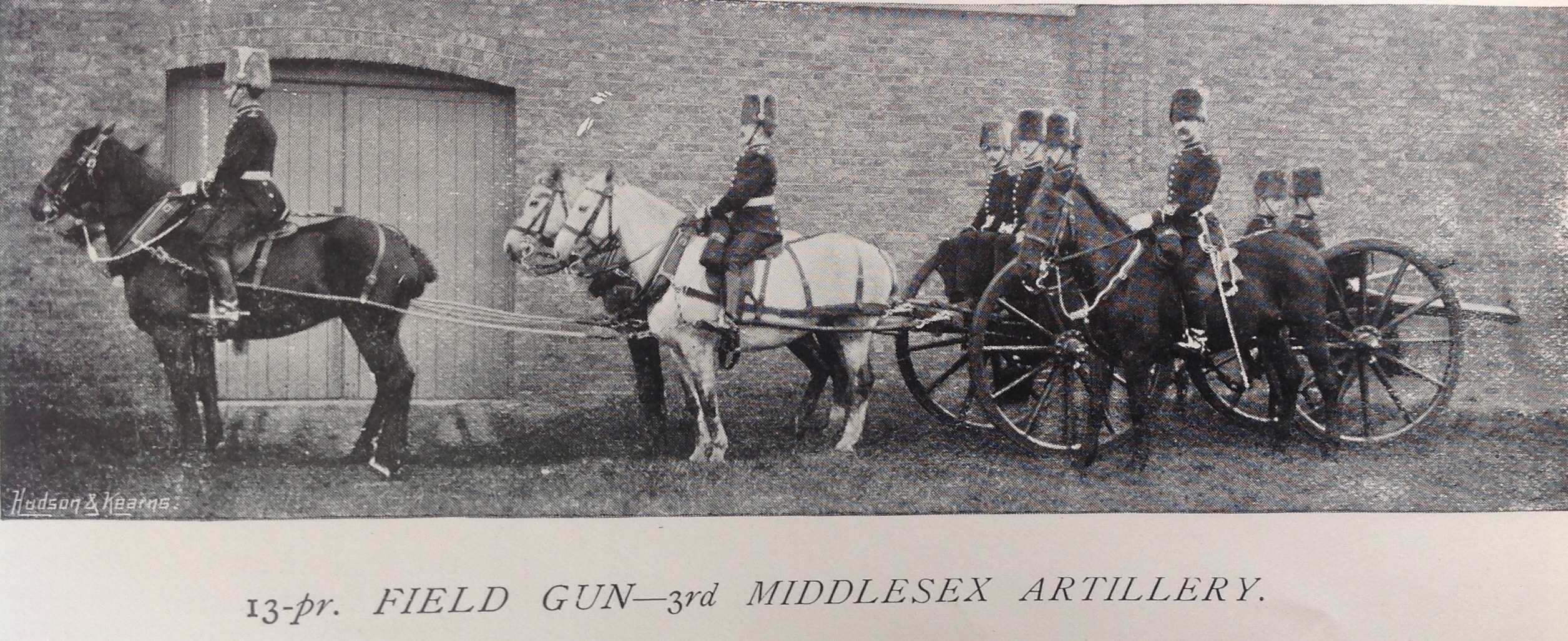
(Photograph courtesy of Wikipedia.com)
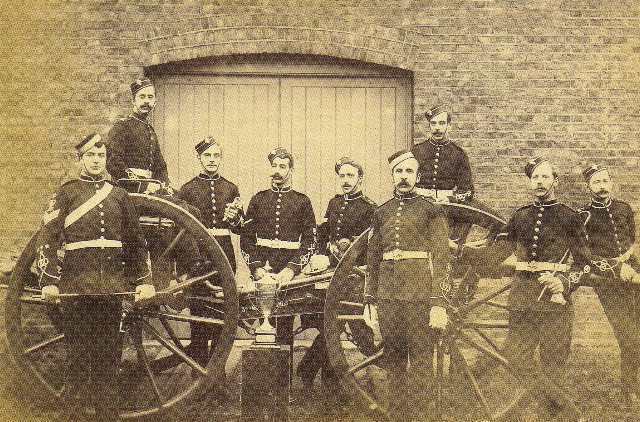
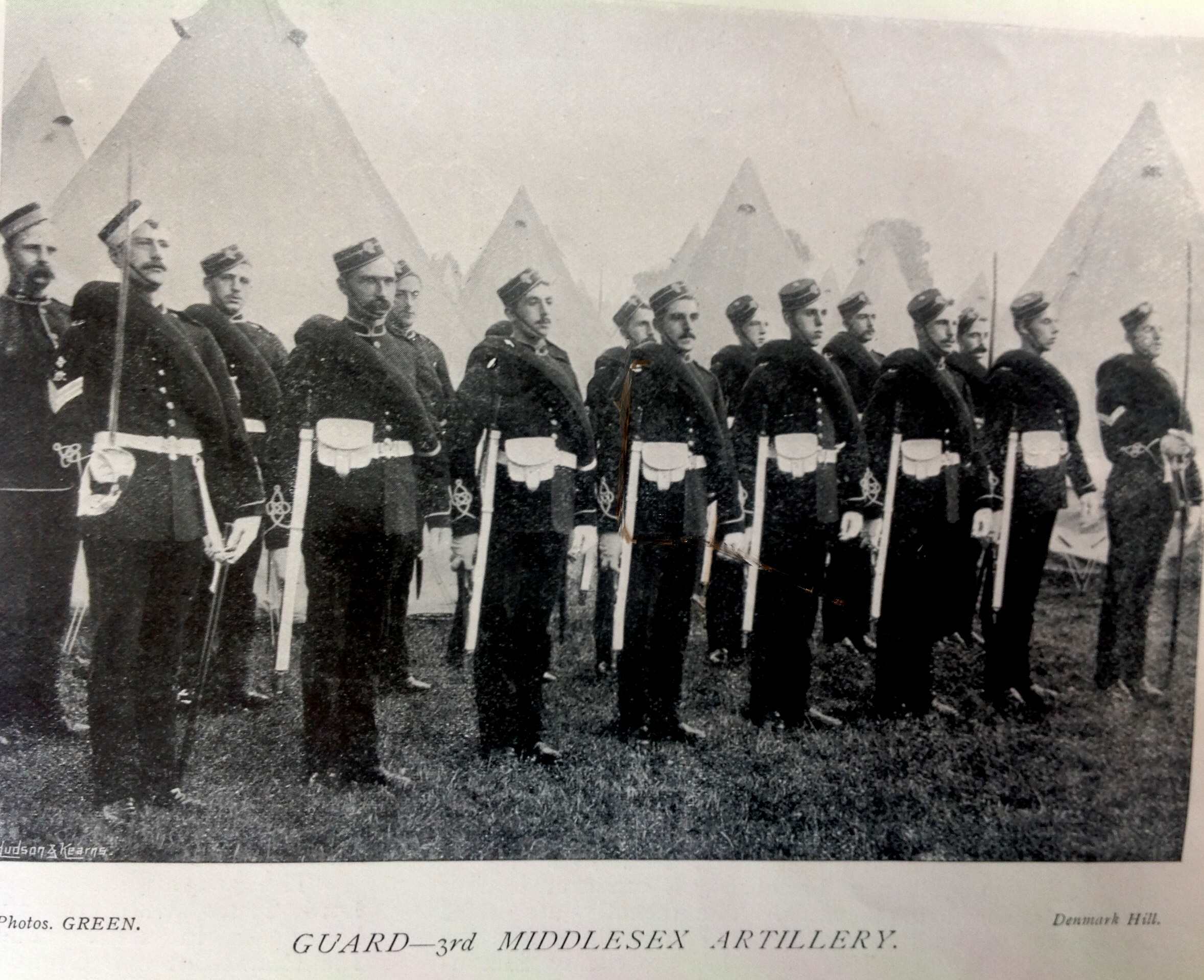
Figure 11 (Right). The Third
Middlesex Volunteer Artillery on Parade in Camp.
(Photographs courtesy of Wikipedia.com)
Commissioning and Training
Merrett was commissioned a 2nd Lieutenant from the ranks in the Royal Engineers Volunteers on the 24th of June 1902. He was posted to the Electrical Engineers, Royal Engineers (V) and reported to the unit’s Drill Hall at 46 Regency Street in Westminster, S.W. He may have gone to the School of Military Engineering at Chatham for some officer training, but that is not indicated in his military service record. After ten years of serving in the ranks of the London Electrical Engineers he certainly was well acquainted with military life. His education and experience in civil life as an engineer certainly qualified him for a commission in this branch of the Royal Engineers.[16] In 1911 he did attend the Royal Engineers School of Electric Lighting at Fort Gilkicker at Stokes Bay in Gosport.
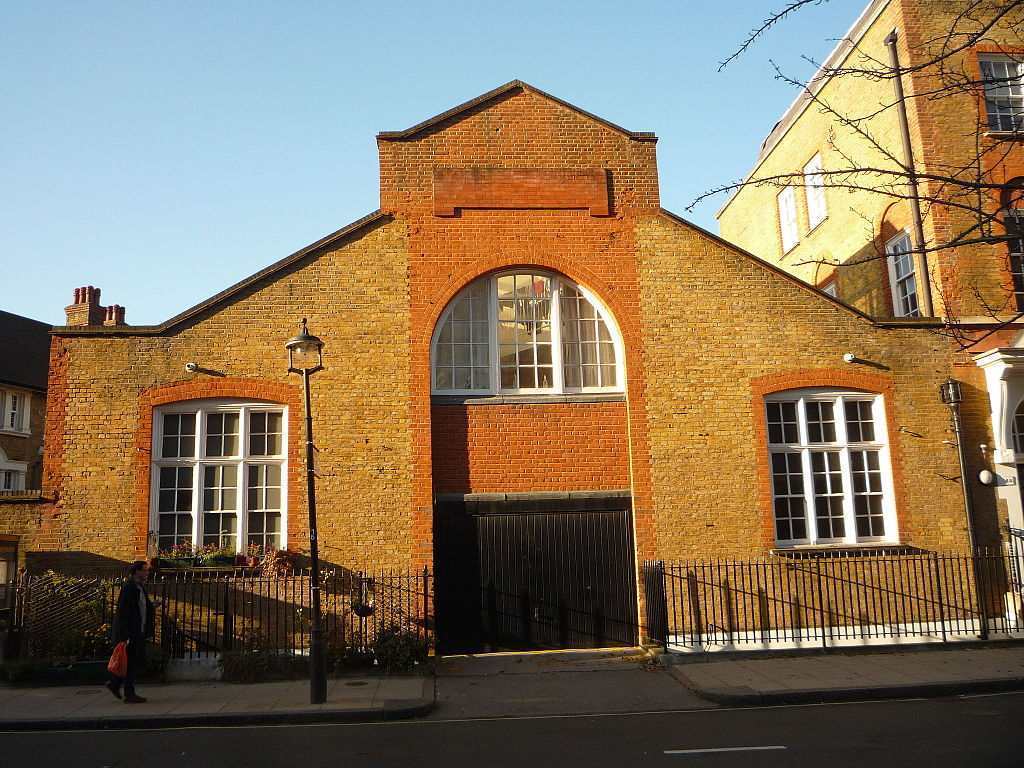
Figure 12. The London
Electrical Engineers Drill Hall,
46 Regency Street, Westminster.[17]
On the 7th of April 1904, while he was still an Instructor in
the Royal School of Mines, he was promoted to the rank of Lieutenant.
On the 1st of April 1908 he was promoted to the rank of
Captain in the Electrical Engineers, R.E. and in this same month he was awarded
the Volunteer Long Service Medal for 20 years of combine service in the ranks
and as an officer.
Assignments
and Home Service
From 1909 to 1910 Merrett served as the Officer Commanding the University of London Officers Training Corps. He appears to have continued with his research work at the Royal School of Mines until he was mobilized for active service with the London Electrical Engineers on the 29th of July 1914 when he was posted to No. 1 Company in London. This company and other companies of the London Electrical Engineers were charged with coast-defence and anti-aircraft duties.
By the outbreak of Great War in August 1914, the London Electrical Engineers had grown to six companies based at Regency Street. Searchlight units were immediately deployed to the South Coast of England and the Thames Estuary to form light barriers against surface raiders. On the 29th of July 1915 Merrett was appointed a Temporary Major in the Electrical Engineers, R.E.[18] The London Gazette dated the 10th of December 1915 shows that Major Merrett was awarded the Territorial Decoration during the previous month. On the 1st of June 1916 he received a promotion to the substantive rank of Major and on the 16th of September he was posted from No. 1 Company to the Depot Company of the London Electrical Engineers located Regency Street. This was a temporary assignment that lasted only 9 days. On the 26th of September he was posted to the 52nd London Anti-Aircraft Company, London Electrical Engineers, probably as the Officer Commanding the company. This company also appears to have been stationed in the London area.
On the 7th of July 1917 Merrett returned to the Depot Company, again for only a few days, until he could be processed for posting to No. 2 Company, London Electrical Engineers. No. 2 Company London Electrical Engineers was positioned at Coalhouse Fort in East Tilbury and was an anti-aircraft searchlight company. With the rank of Major, Merrett probably took command of that company and he remained with that unit for almost a year.
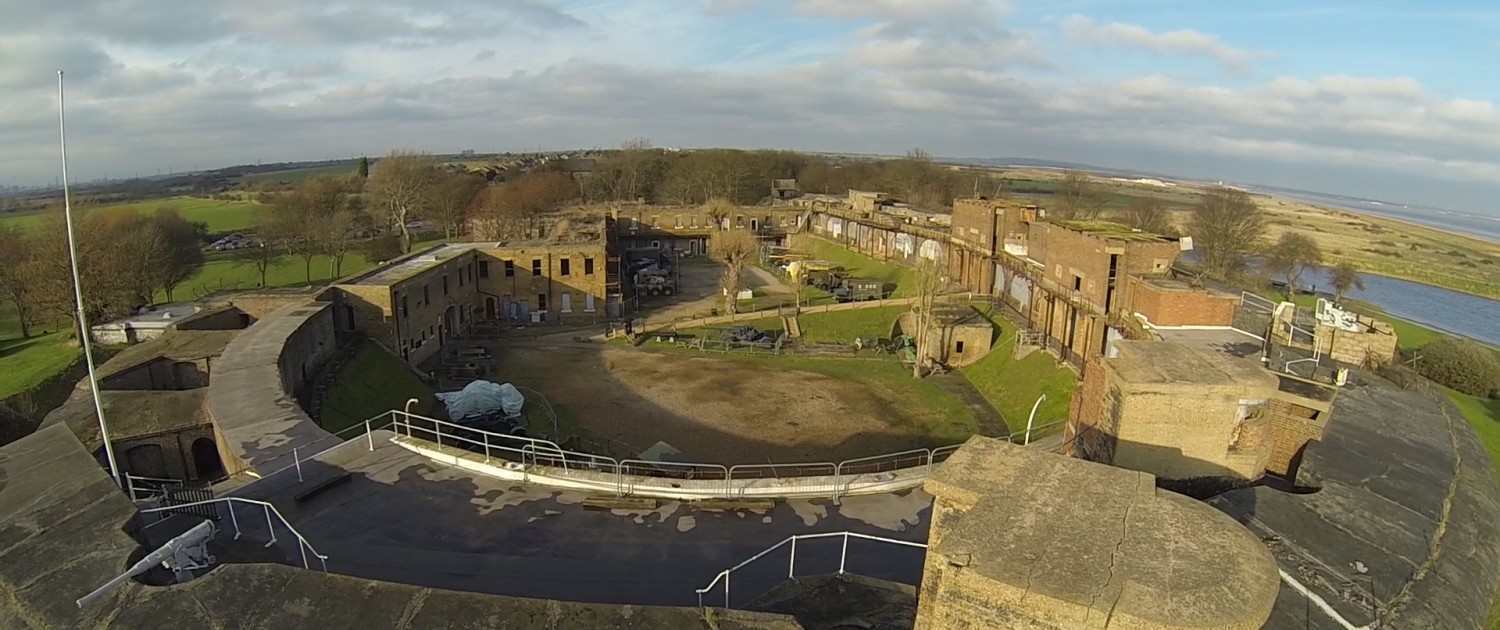
Figure
13. Coalhouse Fort, East Tilbury.
(Photograph
courtesy of Wikipedia.com)
On the 10th of June 1918 Captain Merrett was posted to the 599th London Fortress Company, London Electrical Engineers. This is how this unit is listed in Merrett’s service record; however, the actual designation of the unit was the 599th (Thames & Medway) Fortress Company.[19] He remained with this company for a very short period of time and on the 16th of July he was posted to the Depot Company, London Electrical Engineers and was attached to the Ordnance College at Woolwich as the Chief Instructor in metallurgy, chemistry and explosives.
Effective on the 1st of September 1918 Merrett received the special appointment as the Chief Instructor at the Ordnance College. This came about at the request of the Commandant of the Ordnance College who in a memo dated the 28th of September 1918 had recommended to the War Office that Merrett receive this appointment with the effective date of the first of the month. On the 26th of October 1918 the Director of Artillery at the War Office wrote this letter to the Commandant of the Ordnance College:
“With reference to your minute No. 7169 dated 28th
September 1918, please note that approval is hereby given to the appointment of
Major W.H. Merrett, London Electrical Engineers, R.E. (T), as temporary Chief
Instructor, Ordnance College, with effect from the 1st. September,
inclusive, at a Salary of £600 per annum, while performing the duties of
Professor of Chemistry and Metallurgy.
It is interesting to note that Merrett was to be paid a salary while performing these duties. One wonders if this money was to be his sole income or whether it was in addition to his pay while serving as a Major in the Territorial Force.
Merrett was disembodied from military service on the 30th of April 1919. His Protection Certificate was issued to him on the 1st of May 1919 from No. 2 Dispersal Unit at Crystal Palace. The following information was contained on the certificate:
· Substantive Rank: Major. The word “Major” was followed by the date 7-5-1919, which does not correlate with his actual date of permanent promotion.
· Dispersal Area: No. 10A.
· Theater of War or Command: Eastern – 4. This entry is confusing as all of his service was performed at home. By “Eastern” the entry might be referring to the eastern U.K. where he did serve, but the number 4 is confusing because the theatre of war indicating by “4” was the Middle East and/or Africa depending on the time frame during which a soldier served in those theatres.
· Command: R.E. London Electrical.
· Unit at which last serving: Ordnance College. Here the question of “salary” arises again. If his assignment to the Ordnance College was considered to be a military assignment, was he receiving an extra £600 while serving there?
· Place of rejoining in case of emergency: Chatham.
· Occupation in Civil Life: Staff, Royal School of Mines.
· Born in the year: 1871.
· Medical category: A1. This medical category indicates that he was fit for dispatching overseas, as regards physical and mental health, and training, so at age 48 Merrett was still in good shape.
· Married or single: Single.
· Permanent address: Hatherly, Grosvenor Rd., Wallington, Surrey.
Merrett was disembodied from military service because of the end of the Great War, but he was able to remain in the London Electrical Engineers, R.E. in some capacity until early in 1922. Exactly what this capacity might have been is not indicated in his service papers. On the 24th of February 1922 he received notice from the War Office that he was to be retired from military service having attained the age limit. He was permitted to retain his rank and to wear the prescribed uniform of the Royal Engineers.
Seven months later Merrett took some action to return to military service. On the 11th of October 1922 he entered into an agreement to serve in a Royal Engineers Battalion of the Anti-Aircraft Brigade. The Royal Engineers function in an anti-aircraft role dealt exclusively with the searchlights used to illuminate attacking enemy aircraft. The Royal Artillery was responsible for manning the guns to shoot down the aircraft.[20] This “agreement” actually was an application for a commission. Part of the application required that he indicate his qualifications. In addition to his service in the London Electrical Engineers, Merrett stated that he had been a Member of the University of London Military Education Committee (the Officer Training Corps), a Member of the University of London Nomination Board for Commissions (again the O.T.C) and that he was able to ride a horse.[21] He further stated that he had not served abroad during the Great War. As part of this application Merrett received a medical examination, the results of which have previously been described. He was determined to be fit for a commission in the Territorial Force.
On the day following his application Merrett was recommended by the Officer Commanding the 11th Anti-Aircraft Battalion for a commission in the 3rd Anti-Aircraft Battalion, R.E. (T.A.). It appears from documents in Merrett’s files that he was interviewed by the O.C. of the 11th Battalion as part of his application. Apparently there was no vacancy in that battalion for a Major, so he was recommended for a commission in the 3rd Battalion. How long he may have served in the 3rd Anti-Aircraft Battalion is not shown in his service papers; however by late 1924 his records show that he was serving in the 27th Anti-Aircraft Battalion, R.E.
A War Office letter in his files dated the 18th of October 1924 indicates that he had been approved to serve for two years beyond the age limit and that he was due for retirement on the 17th of November 1924. This letter also indicated that a request for special retention was needed to keep him beyond this date. On the 7th of November 1924 the Officer Commanding the 27th Anti-Aircraft Battalion submitted a request on Merrett’s behalf for a one year extension of service. The War Office approved this request on the 17th of November.
Major Merrett served with the 27th (London) Anti-Aircraft Battalion (London Electrical Engineers), R.E. (T.A.) until he was retired from the Army. This battalion was a searchlight unit with headquarters at Streatham in south London. The battalion consisted of four anti-aircraft companies, the 304th , 305th , 306th and 309th all located in the Westminster area.
On the 23rd of January 1926 the General Officer Commanding the London District wrote to the War Office to say that he did not recommend Major Merrett for further retention in the Army because of his age. He was then 55 year old. On the 1st of February 1926 the War Office indicated that Merrett had attained the age limit for retention and that he would be retired from the Territorial Army. This action took place almost immediately and on the 10th of February 1926 Merrett’s military records were finally closed.
PART II.
SUMMARY
The purpose of
this section is to present in tabular form a summary of the most significant
events in Major Merrett’s life that have been described in the Narrative
section of this work.
5.
MILITARY PROMOTIONS AND MILITARY AND CIVIL APPOINTMENTS
William Henry
Merrett received the following promotions during his time in service.
Table 4. Military Promotions.
Date of Promotion or Appointment |
Rank
or Position |
|
1888 |
Gunner, Middlesex Artillery Volunteers. |
|
1898 |
Sapper, Corps of Royal
Engineers.(1) |
|
24 June 1902 |
2nd Lieutenant, Royal Engineers Volunteers (from the ranks). |
|
7 April 1904 |
Promoted Lieutenant,
Electrical Engineers, R.E. (T.F.)(2) |
|
1 April 1908 |
Promoted Captain, Electrical Engineers, R.E. (T.F.) |
|
29 July 1915 |
Appointed Temporary Major, Electrical Engineers, R.E. (T.F.) |
|
1 June 1916 |
Promoted Major London Electrical Engineers, R.E. (T.F.) |
NOTES:
(1) Available references show that he transferred from the Artillery Volunteers into the Royal Engineers as a Sapper; however, given the 10-year span of time that he was serving in the artillery he may well have transferred into the Royal Engineers at a higher rank.
(2) This promotion was announced in the London Gazette of 10 May 1904.
Major Merrett received the following appointments during his time in service.
Table 5. Military Appointments.
Date of Appointment |
Position |
|
24 June 1902 |
Assigned to the Electrical Engineers, Royal Engineers Volunteers. |
|
1909-1910 |
Officer Commanding, University of London Officers Training Corps. |
|
29 July 1914 |
Posted to No. 1 Company, London Electrical Engineers. |
|
16 September 1916 |
Posted to the Depot Company, London Electrical Engineers. |
|
23 September 1916 |
Posted to No. 52 London Anti-Aircraft Company, London Electrical Engineers. |
|
7 July 1917 |
Posted to the Depot Company, London Electrical Engineers. |
|
12 July 1917 |
Posted to No. 2 Company, London Electrical Engineers. |
|
10 June 1918 |
Posted to the 599th Fortress Company, London Electrical Engineers. |
|
16 July 1918 |
Posted to the Depot Company, London Electrical Engineers. |
|
1 September 1918 |
Posted as a Chief Instructor to the Ordnance College. |
|
17 November 1922 |
Posted to the 11th Anti-Aircraft Battalion, R.E. |
|
18 October 1924 |
Serving with the 27th Anti-Aircraft Battalion, R.E. (date of posting unknown). |
Table
6. Civil Appointments.
Date of Appointment |
Position |
|
1894 |
Private Research Assistant to Sir William Roberts-Austen and Junior Assistant in the research laboratory of the Royal Mint. |
|
1898 |
Senior Research Assistant to Sir William Roberts-Austen, Member of the Alloys Research Committee, Research for H.M. Explosives and Ordnance Committees. |
|
1901 |
Appointed an Associate of the Royal School of Mines. |
|
1902 |
Appointed a Full Member of the Staff of the Royal School of Mines. |
|
1908-1911 |
Assigned as a Lecturer in the Royal School of Mines and Assistant Professor of Metallurgy. |
Merrett
received the following military training during his time in service.
Table 7. Military Training.
Dates |
Course
of Training |
|
1888 |
Basic Gunnery with the 3rd Middlesex Artillery Volunteers.(*) |
|
1898 |
Engineer Recruit Training at the School of Military Engineering, Chatham.(*) |
|
1902 |
Basic Engineer Officer Training at the School of Military Engineering, Chatham.(*) |
|
1911 |
Royal Engineers School of Electric Lighting, Portsmouth. |
|
1917 |
Anti-Aircraft School of Electric Lighting, Portsmouth. |
NOTE: Each item in the table above that is marked with an (*) is training that the author has assumed that Merrett received during the years indicated. These courses of training are not specifically noted in his service papers.
Table 8. Military
Qualifications.
Date |
Qualification |
|
1 April 1908 |
Certificate of Proficiency as an Electrical Engineer, Royal Engineers. |
|
29 July 1914 |
Subaltern, Anti-Aircraft Searchlight Company, Royal Engineers. |
|
1 June 1916 |
Field Officer, Anti-Aircraft Searchlight Company, Royal Engineers. |
|
17 November 1922 |
Field Officer, Anti-Aircraft Searchlight Battalion, Royal Engineers. |
Table
9. Military Medals.
|
Date |
Medal
or Award |
|
April 1908 |
Awarded the Volunteer Long Service Medal (EVIIR) named to CAPTAIN W.H. MERRETT. E.E. R.E.V.[22] |
|
November 1915 |
Awarded the Territorial Decoration (GVR).[23] |
NOTE: All of Major Merrett’s service during the Great War of 1914-1918 was Home Service, thereby making him ineligible to receive the British War Medal or Victory Medal.
Major Merrett was released from service on the 10th of
February 1926. His total service was
reckoned as shown in the table below.
Table
10. Periods of Service.
Location |
Period
of Service |
|
Volunteer Service (Royal Artillery) |
1888 - 1898 |
|
Volunteer Service (Royal Engineers) |
1898- 28 July 1914 |
|
War Service (Royal Engineers) |
29 July 1914 – 30 April 1919 |
|
Territorial Army Service (Royal Engineers) |
1 May 1919 – 10 February 1926 |
|
Total (Home) Service: |
Approximately
38 years |
Following the Great War William Henry Merrett worked as a researcher for the War Office and the Admiralty, performing various studies dealing with complex metallurgical problems. He also returned to teaching metallurgy at various institutions.
The 1928 Electoral Rolls show William Henry Merrett residing at 35 Grosvenor Road in Wallington, London. A Henry Merrett and an Anna (Annie?) Marie Merrett are shown living at the same address. One may assume that he returned to his position on the staff of either the Royal School of Mines or the University of London. He fully retired in 1937. There are no records available to show if he ever married; however, in his will he left a portion of his estate to one Annie Maria Merrett, widow. It could not be determined if this woman was his wife or the widow of a relative.
William Henry Merrett died on the 28th of October 1938, aged 66 years, at Mulgrave Road in Sutton, Surrey. His will was probated on the 12th of December 1938 with his estate going to Annie (Anna?) Maria Merrett, widow, and Henrietta Wraight, his sister, and wife of Ernest Alfred Wraight. His total effects amounted to £13,121 6s 9d. Merrett appears to have done well in his profession. His estate in 2018 U.S. Dollars would have been worth about $1,371,000.
ADDENDUM
NO. 1
A marriage certificate has been located to indicate that William Henry
Merrett married Annie Maria Smith on the 3rd of July 1919.
Their marriage was solemnized at Holy Trinity Church in the Parish of
Wallington, in the County of Surrey.[1]
William is listed as a 47-year old bachelor and Assistant Instructor of
Metallurgy at the Royal School of Mines. His
address is given at “Hatherley” on Grosvenor Road in Wallington.
His father is shown as Henry Merrett, a Hydraulic Engineer.
Annie is listed as a 48-year old spinster.
Her address is given as Melford Lodge, Manor Road, Wallington.
Her father is shown as Thomas Francis Smith, a Mechanical Engineer.
This marriage certificate therefore clarifies the issue in Section 9 of
the narrative as to whether Merrett was married and who “Annie (Anna?) Maria
Merrett, widow” as shown in his will really was.
The fact that Annie’s father was a Mechanical Engineer certainly must
have played a part in how William and Annie came to meet.
William’s father may have known Thomas Francis Smith or William may
have been acquainted with him through his work at the Royal School of Mines.
Since William was disembodied from military service on the 30th of April 1919 it appears from this marriage certificate that he almost immediately returned to the Royal School of Mines after leaving the Army.
ADDENDUM
NO. 2
William Henry Merrett’s wife, Annie Maria Smith was born in 1871 in
Birmingham, Warwickshire, the daughter of Thomas Francis and Emma Smith.
She died on the 21st of June 1956 at the age of 85.
Her residence at the time of her death was “Westfield,” 60, The
Avenue, Worcester Park, Surrey; however, her place of death is listed as
Crowstone Road, Westcliff-on-Sea, Essex.
Annie Merrett’s will was probated at London on the 21st of
September 1956 to the Westminster Bank Limited.
Her effects amounted to £33,255 8s 8d, a tidy sum that would equal
approximately US $1,071,900 in 2018. At
the time of his death William’s estate was valued at about US $1,371,000.
It appears that Annie was able to retain most of the principal that she
inherited after his death.
The 1956 Probate Register reads “Probate London
21 September to Westminster Bank Limited” and does not contain the name of a
legatee. It is not clear what
happened to her money.
Books
Census Data
Internet
Web Sites
London
Gazette
1.
1.
The
London Gazette, May 10, 1904, p. 3006.
2.
The
London Gazette, December 29, 1908, p. 9758.
3.
The
London Gazette, 23 September 1915, p. 9414.
4.
The
London Gazette, 10 December 1915, p. 12335.
Medal
Rolls
Electrical
Engineers, Royal Engineers Volunteers Medal Roll, based on the naming on the
Volunteer Long Service Medal.
Periodicals
Registers
Service Papers
a. Protection Certificate (Officer). Army Form Z.3.
b. Letter to the War Office from the Commandant, Ordnance College, dated 28th September 1918.
c. Letter to the Commandant, Ordnance College from the War Office, dated 26th October 1918.
d. War Office form for final closing of military records, 1 February 1926.
e. London Electrical Engineers Note dated 24 February 1922.
f. Letter from the Horse Guards, dated 18 October 1924, regarding Merrett’s retirement date.
g. Letter from W.H. Merrett to the War Office, dated 16 February 1922 regarding his retirement.
h. Note, Corps of Royal Engineers, 11th Anti-Aircraft Battalion, dated 17 November 1922 [GAZETTE 22 Nov 1922].
i. Letter from the Horse Guards dated 15 November 1924, granting Merrett and extension of service for two years.
j. Application for Appointment to a Commission in the Territorial Force with Agreement to join an Anti-Aircraft Defence Unit, dated 11 October 1922.
k. Extract from Record of Service.
l. Letter from the War Office to the O.C., 27th Anti-Aircraft Battalion, dated 1 February 1926.
m.
Letter from the General Officer Commanding, London District, to
the War Office, dated 23 January 1926.
[1] Currently known as the British Science Association.
[2] 1871 Census of England and Wales.
[3] This address no longer exists in Croydon. The property is now occupied by a large apartment complex.
[4] There is no building currently at this address.
[5] These numbers represent the results of the Snellen test for visual acuity. Visual acuity is measured using the Snellen scale. A Snellen test usually consists of a number of rows of letters which get smaller as you read down the chart. On the Snellen scale, normal visual acuity is called 6 / 6, which corresponds to the bottom or second bottom line of the chart. If one can only read the top line of the chart then this would be written as 6 / 60. This means that one can see at 6 meters what someone with standard vision could see from 60 meters away. In Merrett’s case his uncorrected visual acuity was 6/36 meaning that he could see at 6 meters what someone with standard or normal vision could see at 36 meters.
[6] Today, the RSM no longer exists as an academic entity. The RSM is both the building in which the departments are housed, and the student body that organizes social events, sports teams, clubs and societies for students within those departments.
[7] Grace’s Guides: Obituary and Who’s Who.
[8] Ibid.
[9] Ibid.
[10] Register of the Associates and Old Students of the Royal School of Mines.
[11]https://books.google.com/books?id=1WVCAQAAMAAJ&pg=PA1319&lpg=PA1319&dq=William+H.+Merrett+Institution+of+Mechanical+Engineers&source=bl&ots=O8ZCH-N6NM&sig=UsQ9RjrWC5CtKnbmKTZsc6wDgG0&hl=en&sa=X&ved=0ahUKEwiM-tu9wLLZAhUQON8KHVAFCUYQ6AEIKTAA#v=onepage&q=William%20H.%20Merrett%20Institution%20of%20Mechanical%20Engineers&f=false
[12] Grace’s Guide: Who’s Who in Engineering.
[13] The Mining Magazine.
[14] The St. Neots Derailment 1895 occurred near to St. Neots railway station on 10 November 1895 when a Great Northern Railway Scottish express from Kings Cross encountered a broken rail. The train left Kings Cross on time at 23:30 on Saturday night and proceeded at normal speed, which would have been about 50 mph. It was hauled by one of the GNR's latest and largest of its 8-foot singles, number 1006. The train consisted of eight vehicles: a guard's van, a coach, a Pullman sleeping car (Iona), a corridor coach, another sleeping car, two further coaches and a final guard's van. Fortunately it was only carrying twenty seven passengers. About forty yards south of St. Neots station a broken rail derailed the train, the coupling of the second sleeping car parting. The hind part of the train veered to the left and struck a row of goods wagons in a siding to the north of the station. The forward part of the train came to a stand about a quarter of a mile further on. There was one death, a lady called Louisa O'Hara who was propelled out of the sleeping car and struck her head against a goods wagon. Some four to six passengers were more or less severely injured, the guard also having struck his head.
[15] As this membership was in a foreign institute it does not appear in the postnominals used with Merrett’s name in other documents.
[16] In 1909 his membership in the Institution of Electrical Engineers had been upgraded from Associate to the class of Associate Member.
[17] By Rickfive - Own work, CC BY-SA 4.0, https://commons.wikimedia.org/w/index.php?curid=37212209.
[18] The London Gazette, 23 September 1915.
[19] KENT FORTRESS ROYAL ENGINEERS. https://en.wikipedia.org/wiki/Kent_Fortress_Royal_Engineers#Other_units
[20] By 1940 the searchlight commitment within the Corps of Royal Engineers had become considerable and began to conflict operationally with the role of the Royal Artillery and Royal Air Force. Additionally, the A.A. S/L work distracted the Corps from its true role of military engineering. Just as the Royal Flying Corps, the Tanks, the Royal Corps of Signals and others had in due course gone their own way, so did the anti-aircraft searchlight mission. Pressures from the Royal Artillery to take over the entire anti-aircraft searchlight role in 1940 were not resisted by the Royal Engineers, except by units that did not relish being converted once again to another corps. However, the conversion of 27 Anti-Aircraft Battalions of the Royal Engineers into Searchlight Regiments of the Royal Artillery was completed by early 1941, at which point the enormously important and successful story of the A.A. Searchlights in the Royal Engineers came to an end.
[21] This unusual question on the application form fell in amongst the other questions regarding his qualifications.
[22] Medal in author’s collection.
[23] Replica medal in author’s collection.